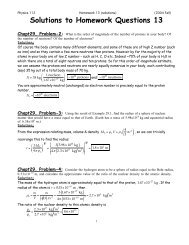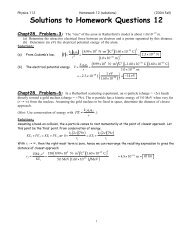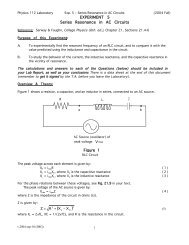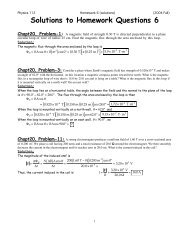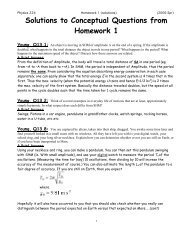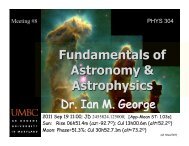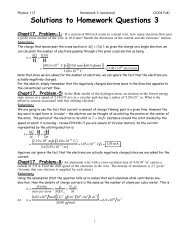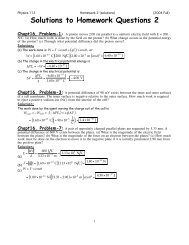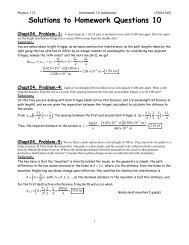Solutions to Homework Questions 7
Solutions to Homework Questions 7
Solutions to Homework Questions 7
- No tags were found...
Create successful ePaper yourself
Turn your PDF publications into a flip-book with our unique Google optimized e-Paper software.
Physics 112 <strong>Homework</strong> 7 (solutions) (2004 Fall)<br />
<strong>Solutions</strong> <strong>to</strong> <strong>Homework</strong> <strong>Questions</strong> 7<br />
Chapt21, Problem-3: An AC power supply produces a<br />
maximum voltage of !V max = 100 V. This power supply is connected<br />
<strong>to</strong> a 24.0-" resis<strong>to</strong>r, and the current and resis<strong>to</strong>r voltage are measured<br />
with an ideal AC ammeter and an ideal AC voltmeter, as shown in<br />
Figure P21.3. What does each meter read Recall that an ideal ammeter<br />
has zero resistance and an ideal voltmeter has infinite resistance.<br />
Solution:<br />
The meters measure the rms values of potential difference<br />
and current. These are<br />
!V rms = !V max<br />
2<br />
and I rms = !V rms<br />
R<br />
= 100 V<br />
2 = 70.7 V ,<br />
= 70.7 V<br />
24.0 " = 2 .95 A<br />
Chapt21, Problem-5: An audio amplifier, represented by the<br />
AC source and the resis<strong>to</strong>r R in Figure P21.5, delivers alternating voltages at<br />
audio frequencies <strong>to</strong> the speaker. If the source puts out an alternating voltage<br />
of 15.0 V (rms), resistance R is 8.20 " and the speaker is equivalent <strong>to</strong> a<br />
resistance of 10.4 " what is the time-averaged power delivered <strong>to</strong> the speaker<br />
Solution:<br />
The <strong>to</strong>tal resistance (series connection) I<br />
s R eq = R 1 + R 2 = 8.20 ! +10.4 ! = 18.6 ! ,<br />
so the current in the circuit is<br />
I rms = !V rms<br />
= 15.0 V<br />
R eq<br />
18.6 " = 0.806 A<br />
2<br />
The power <strong>to</strong> the speaker is then ! av = I rms R spea ker = ( 0.806 A ) 2 ( 10.4 ")= 6.76 W<br />
Chapt21, Problem-11: What value of capaci<strong>to</strong>r must be inserted in a 60-Hz circuit in series with a genera<strong>to</strong>r<br />
of 170 V maximum output voltage <strong>to</strong> produce an rms current output of 0.75 A<br />
Solution:<br />
I rms = !V rms<br />
X C<br />
so C =<br />
#<br />
=2" fC !V max<br />
%<br />
$ 2<br />
I<br />
! f "V max<br />
&<br />
( = " fC (!V max ) 2 ,<br />
'<br />
( ) 2 = 0.75 A<br />
! ( 60 Hz) ( 170 V) 2 = 1.7 # 10$5 F =<br />
17 µF<br />
1
Physics 112 <strong>Homework</strong> 7 (solutions) (2004 Fall)<br />
Chapt21, Problem-16: A 2.40-µF capaci<strong>to</strong>r is connected across an alternating voltage with an rms value of<br />
9.00 V. The rms current in the circuit is 25.0 mA. (a) What is the source frequency (b) If the capaci<strong>to</strong>r is replaced by an<br />
ideal coil with an inductance of 0.160 H, what is the rms current in the coil<br />
Solution:<br />
(a)<br />
I rms = !V rms<br />
X C<br />
= (!V rms )( 2" fC), so<br />
I<br />
f = rms<br />
( )2" C = 25.0 # 10 $3 A<br />
( 9.00 V)2" 2.40 #10 $6 F<br />
!V rms<br />
(b)<br />
I rms = !V rms<br />
X L<br />
( )<br />
= !V rms<br />
2" fL = 9.00 V<br />
2" 184 Hz<br />
= 184 Hz<br />
( )( 0.160 H ) = 4.86 # 10$2 A =<br />
48.6 mA<br />
Chapt21, Problem-20: A series AC circuit contains the following components: R = 150 !, L = 250 mH,<br />
C = 2.00 µF, and a genera<strong>to</strong>r with "V max = 210 V operating at 50.0 Hz. Calculate the (a) inductive reactance, (b) capacitive<br />
reactance, (c) impedance, (d) maximum current, and (e) phase angle between the current and the genera<strong>to</strong>r voltage.<br />
Solution:<br />
X L = 2! fL= 2! ( 50.0 Hz) ( 0.250 H)= 78.5 !<br />
(a)<br />
1<br />
(b) X C =<br />
2! fC = 1<br />
2! 50.0 Hz<br />
( ) = 1.59 " 103 $ =<br />
( ) 2 .00" 10 #6 F<br />
(c) Z = R 2 + ( X L ! X C ) 2 = ( 150 ") 2 + ( 78.5 "!1.59 #10 3 ") 2 =<br />
(d) I max = !V max<br />
Z = 210 V<br />
138 mA<br />
1.52 "10 3 = 0.138 A =<br />
#<br />
(e) ! = tan "1 # X L<br />
" X C & #<br />
% ( = tan "1 78.5 )"1.59* 103 )&<br />
$ R '<br />
%<br />
( = " 84.3° ,<br />
$ 150 ) '<br />
or<br />
the current leads the voltage by 84.3°<br />
1.59 k!<br />
1.52 k!<br />
Chapt21, Problem-25: A person is working near the<br />
secondary of a transformer, as shown in Figure P21.25. The primary<br />
voltage is 120 V (rms) at 60.0 Hz. The capacitance C s , which is the<br />
stray capacitance between the hand and the secondary winding, is 20.0 pF.<br />
Assuming the person has a body resistance <strong>to</strong> ground of R b = 50.0 k!,<br />
determine the rms voltage across the body. (Hint: Redraw the circuit with<br />
the secondary of the transformer as a simple AC source.<br />
Solution:<br />
1<br />
X C =<br />
2! fC = 1<br />
2! 60.0 Hz<br />
( ) = 1.33" 108 $<br />
( ) 2 + ( 1.33! 10 8 ") 2 = 1.33 !10 8 "<br />
( ) 20.0 "10 #12 F<br />
Z RC = R 2 + X C 2 = 50.0 ! 10 3 "<br />
( ) rms<br />
20.5 H<br />
and I rms = !V 200 V<br />
secondary 5 000 V<br />
=<br />
Z RC<br />
1.33 "10 8 # = 3.76 "10 100 Hz<br />
$5 A<br />
35.0 !<br />
Therefore, !V b,rms = I rms R b = ( 3.76 "10 #5 A) ( 50.0 "10 3 $ )= 1.88 V<br />
C<br />
2
Physics 112 <strong>Homework</strong> 7 (solutions) (2004 Fall)<br />
Chapt21, Problem-33: An RLC circuit is used <strong>to</strong> tune a radio <strong>to</strong> an FM station broadcasting at 88.9 MHz.<br />
The resistance in the circuit is 12.0 ! and the capacitance is 1.40 pF. What inductance should be present in the circuit<br />
Solution:<br />
The resonance frequency of the circuit should match the broadcast frequency of the station.<br />
1<br />
f 0 =<br />
2! LC gives L = 1<br />
4! 2 f 2 0<br />
C ,<br />
1<br />
or L =<br />
2 .29 µH<br />
4! 2 88.9 "10 6 Hz<br />
( ) 2 ( 1.40 " 10 #12 F) = 2 .29" 10#6 H =<br />
Chapt21, Problem-35: The AM band extends from approximately 500 kHz <strong>to</strong> 1 600 kHz. If a<br />
2.0-µH induc<strong>to</strong>r is used in a tuning circuit for a radio, what are the extremes that a capaci<strong>to</strong>r must reach in<br />
order <strong>to</strong> cover the complete band of frequencies<br />
Solution:<br />
1<br />
f 0 =<br />
2! LC , so C = 1<br />
4! 2 f 2 0<br />
L<br />
For f 0 = f 0<br />
For f 0 = f 0<br />
( ) min<br />
= 500 kHz = 5.00 !10 5 Hz ,<br />
C = C max =<br />
1<br />
( ) 2 ( 2.0 " 10 #6 H) = 5.1" 10#8 F =<br />
4! 2 5.00 "10 5 Hz<br />
( ) max<br />
= 1600 kHz = 1.60! 10 6 Hz ,<br />
C = C min =<br />
1<br />
( ) 2 ( 2.0 " 10 #6 H) = 4.9 " 10#9 F =<br />
4! 2 1.60 " 10 6 Hz<br />
51 nF<br />
4.9 nF<br />
Chapt21, Problem-41: A transformer on a pole near a fac<strong>to</strong>ry steps the voltage down from 3600 V <strong>to</strong> 120V.<br />
The transformer is <strong>to</strong> deliver 1 000 kW <strong>to</strong> the fac<strong>to</strong>ry at 90% efficiency. Find (a) the power delivered <strong>to</strong> the primary, (b) the<br />
current in the primary, and (c) the current in the secondary.<br />
Solution:<br />
(a) At 90% efficiency, (! av ) output<br />
= 0.90 (! av ) input<br />
.<br />
Thus, if (! av ) output<br />
= 1000 kW ,<br />
(<br />
the input power <strong>to</strong> the primary is (! av ) input<br />
= ! av ) output 1000 kW<br />
= =<br />
0.90 0.90<br />
1.1! 103 kW<br />
(<br />
(b) I 1, rms = ! av ) input<br />
= 1.1 #103 kW<br />
= 1.1# 106 W<br />
"V 1, rms<br />
"V 1, rms<br />
3600 V = 3.1! 102 A<br />
(<br />
(c) I 2, rms = ! av ) output 1000 kW<br />
= = 1.0 #106 W<br />
"V 2, rms<br />
"V 1, rms<br />
120 V = 8.3 !103 A<br />
3
Physics 112 <strong>Homework</strong> 7 (solutions) (2004 Fall)<br />
Chapt21, Problem-43: The U.S. Navy has long proposed the construction of extremely low-frequency<br />
(ELF) communications systems; such waves could penetrate the oceans <strong>to</strong> reach distant submarines. Calculate the length of<br />
a quarter-wavelength antenna for a transmitter generating ELF waves of frequency 75 Hz. How practical is this<br />
Solution:<br />
From v = !f , the wavelength is<br />
! = v f = 3.00" 108 ms<br />
75 Hz<br />
= 4.00" 10 6 m = 4000 km<br />
The required length of the antenna is then,<br />
L = ! 4 = 1000 km , and so rather unfeasible.<br />
Chapt21, Problem-47: A microwave oven is powered by an electron tube called a magnetron that generates<br />
electromagnetic waves of frequency 2.45 GHz. The microwaves enter the oven and are reflected by the walls. The standing<br />
wave pattern produced in the oven can cook food unevenly, with hot spots in the food at antinodes and cool spots at nodes,<br />
so a turntable is often used <strong>to</strong> rotate the food and distribute the energy. If a microwave oven is used with a cooking dish in<br />
a fixed position, the antinodes can appear as burn marks on foods such as carrot strips or cheese. The separation distance<br />
between the burns is measured <strong>to</strong> be 6.00 cm. Calculate the speed of the microwaves from these data.<br />
Solution:<br />
The distance between adjacent antinodes in a standing wave is ! 2 .<br />
Thus, ! = 2( 6.00 cm )= 12.0 cm = 0.120 m , and<br />
c = !f = ( 0.120 m )( 2 .45" 10 9 Hz)= 2.94!108 ms<br />
Chapt21, Problem-50: The eye is most sensitive <strong>to</strong> light of wavelength 5.50x10 –7 m, which is in the<br />
green-yellow region of the visible electromagnetic spectrum. What is the frequency of this light<br />
Solution:<br />
f = c 3.00 "108 ms<br />
=<br />
! 5.50 "10 #7 m = 5.45 !1014 Hz<br />
Chapt21, Problem-52: A diathermy machine, used in physiotherapy, generates electromagnetic radiation<br />
that gives the effect of “deep heat” when absorbed in tissue. One assigned frequency for diathermy is 27.33 MHz. What is<br />
the wavelength of this radiation<br />
Solution:<br />
! = c f = 3.00 "108 ms<br />
27.33 "10 6 Hz = 11.0 m<br />
Chapt21, Conceptual-6: If the fundamental source of a sound wave is a vibrating object, what is the<br />
fundamental source of the electromagnetic wave<br />
Solution:<br />
The fundamental source of an electromagnetic wave is a moving charge. For example, in a transmitting<br />
antenna of a radio station, charges are caused <strong>to</strong> move up and down at the frequency of the radio station.<br />
These moving charges set up electric and magnetic fields, the electromagnetic wave, in the space around<br />
the antenna<br />
4
Physics 112 <strong>Homework</strong> 7 (solutions) (2004 Fall)<br />
Chapt21, Conceptual-7: In radio transmission, a radio wave serves as a carrier wave and the sound wave is<br />
superimposed on the carrier wave. In amplitude-modulation (AM) radio, the amplitude of the carrier wave varies according <strong>to</strong><br />
the sound wave. The Navy sometimes uses flashing lights <strong>to</strong> send Morse code between neighboring ships, a process that has<br />
similarities <strong>to</strong> radio broadcasting. Is this AM or FM What is the carrier frequency What is the ignal frequency What is the<br />
broadcasting antenna What is the receiving antenna<br />
Solution:<br />
The flashing of the light according <strong>to</strong> Morse code is a drastic amplitude modulation – the amplitude is<br />
changing from a maximum <strong>to</strong> zero. In this sense, it is similar <strong>to</strong> the on-and-off binary code used in<br />
computers and compact discs. The carrier frequency is that of the light, on the order of 10 14 Hz. The<br />
signal frequency depends on the skill of the signal opera<strong>to</strong>r, but it is of the order of 1 Hz, as the light<br />
flashes on and off. The broadcasting antenna for this modulated signal is the filament of the lightbulb in<br />
the signal source. The receiving antenna is the eye.<br />
Chapt21, Conceptual-8: When light (or other electromagnetic radiation) travels across a given region, what<br />
is it that moves<br />
Solution:<br />
As an electromagnetic wave travels through space, the things that move are fluctuations in electric and<br />
magnetic fields oriented at right angles <strong>to</strong> one another. These fluctuations in the fields transport energy<br />
as they travel along.<br />
Chapt21, Conceptual-10: How can the average valuue of an alternating current be zero, yet the square root<br />
of the average squared value not be zero<br />
Solution:<br />
The average value of an alternating current is zero because its direction is positive as often as it is<br />
negative, and its time average is zero. The average value of the square of the current is not zero, however,<br />
since the square of positive and negative values are always positive and cannot cancel.<br />
Chapt21, Conceptual-13: Radio stations often advertise “instant news”. If whatt they mean is that you<br />
hear the news at the instant they speak it, is their claim true About how long would it take for a message <strong>to</strong> travel across<br />
this country by radio wave, assuming that these waves could travel this great distance and still be detected<br />
Solution:<br />
Radio waves move at the speed of light. They can travel around the curved surface of the Earth, bouncing<br />
between the ground and the ionosphere, which has an altitude that iss small compared <strong>to</strong> the radius of the<br />
Earth. The distance across the lower 48 states is approximately 5000 km, requiring a travel time of<br />
(5x10 6 m)/(3x10 8 m/s) ~10 -2 s. Likewise, radio waves take only 0.07s <strong>to</strong> travel halfway around the Earth. In<br />
other wordws, a speech can be heard on the other side of the world (in the form of radio waves) before it<br />
is heard at the back of the room (in the form of sound waves).<br />
5






